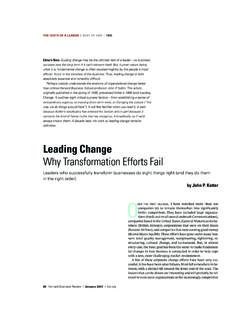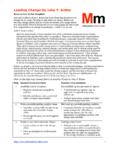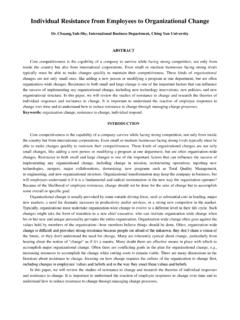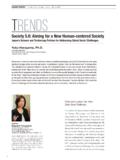Transcription of Bushe Ph.D. James O’Malley - Clear Learning
1 Draft September 2012 CHANGING ORGANIZATIONAL CULTURE THROUGH Clear LEADERSHIP Gervase R. Bushe James O Malley Prepared for The Change Champions Fieldguide, 2nd Ed. John Wiley, 2013 It s an old saying amongst change professionals that organizational change is often something the tops tell the middles to do to the bottoms. And it is equally well known that if the middles are at all successful in changing the bottoms, sustaining change will eventually require the tops to change as well. Organizations are systems, after all, and a significant change in any one part will require changes in other parts.
2 If the tops don t change in response to new conditions and expectations coming up from below, inertia takes over and one more failed change program goes to its grave. Maybe more change can happen more quickly if we start with the tops. It s equally well known amongst anyone in business that organization design and leadership require revolutionary changes. We ve been talking about the need to flatten hierarchies, create teams, empower and engage the workforce for decades now, but the experience of most people is that the good old command and control organization is still in place. Very recently LRN commissioned the Boston Research Group to survey 5,000 American managers and workers to study how decisions get made1.
3 Tellingly, 24% of C suite respondents said their organizations were characterized by collaborative relations where employees could and did make significant decisions. Only 3 % of everyone else said that was true where they worked. Just about every significant organizational innovation of the past 30 years, from lean manufacturing to agile software development, requires this shift in organizing from command and control to collaboration, or as we define it in this chapter, partnership . We define partnership as a relationship in which all parties feel responsible for the success of their mutual endeavor.
4 The most popular explanation for why so little sense of partnership exists in our corporations is that the tops are control freaks who don t want to let go of power. That might explain some of it, but clearly not all of it. Certainly not that 24% of C suite members in LRN s study. In our experience, most people want to work in partnership. They want to feel that the people they work with, their boss, their colleagues and their employees, feel 1 The How Report: Rethinking the Source of Resilience, Innovation and Sustainable Growth.
5 LRN Corporation, 2011. Draft September 2012 2 Changing Organizational Culture Through Clear Leadershipmutually responsible for the success of what they are doing together. It s not a motivation problem. We think it s mostly a skill problem. But it s also a cultural problem, because the way people act toward each other, and the way people lead in any organization, is shaped by organizational culture the set of expectations people have for how things are around here. In trying to change leadership behaviors we ve learned that every organization has a leadership culture the way people expect leaders to act.
6 Even if you teach people new skills they have to feel it is OK, even expected, for them to act in those new ways. If you want to change how people show up as leaders you have to both change their skills and the culture they operate in at the same time. In this chapter we will describe a model that not only explains why efforts to create more collaborative organizations so often fail but offers an integrated, research based set of skills for leaders at all levels of organizations to sustain partnerships. We ll describe how starting with the partnership skills and behaviors amongst the CEO and the executive team is the best, and perhaps only way, to create the cultural platform for all the other productivity and innovation enhancing changes 21st century businesses rely on.
7 We illustrate this through the case of Palomar, a health care provider in southern California with $ billion in annual revenues, that was able to increase employee partnership from the 61st percentile to the 91st percentile of US hospitals, and in the process significantly change their organizational culture, from adopting this perspective. WHAT STARTED AT PALOMAR HEALTH AND WHY. In 2004 Michael Covert was hired as CEO of Palomar Pomerado Health (now Palomar Health). He had a track record of running much larger health care organizations but was excited by the vision the Board had of creating one of the most innovative health care organizations in North America.
8 Armed with a mandate to build a new, state of the art hospital, Covert began building his managerial team and began the process of changing the culture and operation of the organization. One of the early issues he identified was a need to change the complacent, inward focused culture in the organization. A survey using the Organizational Culture Assessment developed by Bob Quinn and Kim Cameron at the University of Michigan confirmed that Palomar Health had a predominant Clan culture . Descriptions of managerial meetings at the time were that everyone was nicey nice . People would support each other even when they didn t agree with one another.
9 There was an unwritten agreement that no one would do anything that would make another person uncomfortable or feel challenged. Front line staff tended to focus more on serving themselves than serving customers. Covert wanted to change the organization from a Clan culture to a Market culture, one Draft September 2012 3 Changing Organizational Culture Through Clear Leadershipthat would be more innovative, willing to use constructive conflict to bring out the best in each other, and more client focused. James O Malley was hired to run leadership and organization development 4 years later, in 2008.
10 James had a background as a hospital administrator and later as an OD consultant. He also was attracted by the mission and vision and the opportunity to create transformational change, anchored by a new hospital that would be built and occupied by 2012. He saw the challenges Palomar Health faced in shifting from a clan culture to a market culture and believed change had to happen at the top for change to happen throughout the system. He also identified a history of doing flavor of the month leadership development programs that would leave people feeling good but not last or make any kind of difference.






